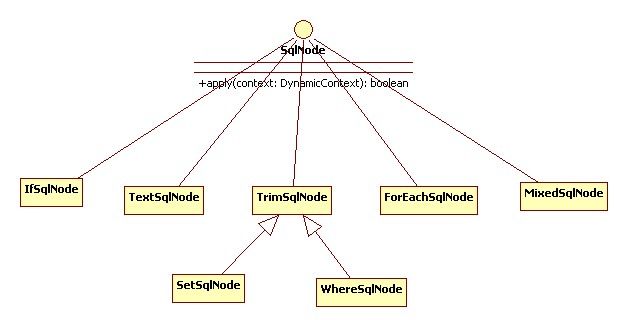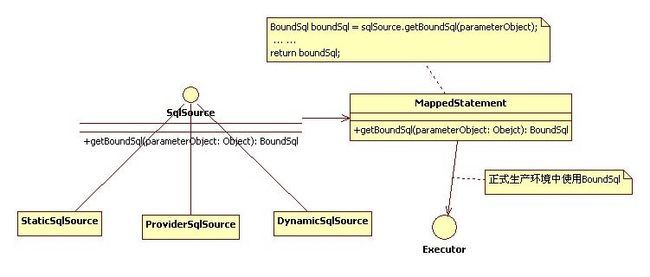ibatis 3.0 Dynamic Sql 设计解析(并与2.x的差异)
前段时间ibatis3.0发布出来了,迫不及待,将其源码下载拜读。相对ibatis 2.x来说,3.0已是完全改变。具体我就不在这细说,论坛中有一个帖子介绍了ibatis 3.0的新特征及使用。
由于其他模块的源码我还未细读,在这篇中,先来讨论Dynamic Sql在ibatis 3.0中的实现并比较2.x对应模块的设计。
写在前头的话:
其实如从设计模式应用角度去看待ibatis 3.0中Dynamic Sql的实现,这篇跟我的上篇(HtmlParser设计解析(1)-解析器模式)相同,都是使用Interpreter模式。
这篇权当Interpreter模式的另一个demo,认我们体会这些开源项目中设计模式的使用。学习都是从模仿开始的,让 我们吸收高人们的经验,应用于我们实践项目需求中。
从总结中提高:
一、对比2.x中与3.0的Sqlmap中dynamic sql配置
2.x:
- <select id="dynamicGetAccountList" parameterClass="Account" resultClass="Account">
- select ACC_ID as id,
- ACC_FIRST_NAME as firstName,
- ACC_LAST_NAME as lastName,
- ACC_EMAIL as emailAddress from ACCOUNT
- <dynamic prepend="WHERE">
- <isNotNull prepend="AND" property="emailAddress">
- ACC_EMAIL = #emailAddress#
- </isNotNull>
- <isNotNull property="idList" prepend=" or ACC_ID in ">
- <iterate property="idList" conjunction="," open="(" close=")" >
- #id#
- </iterate>
- </isNotNull>
- </dynamic>
- </select>
<select id="dynamicGetAccountList" parameterClass="Account" resultClass="Account">
select ACC_ID as id,
ACC_FIRST_NAME as firstName,
ACC_LAST_NAME as lastName,
ACC_EMAIL as emailAddress from ACCOUNT
<dynamic prepend="WHERE">
<isNotNull prepend="AND" property="emailAddress">
ACC_EMAIL = #emailAddress#
</isNotNull>
<isNotNull property="idList" prepend=" or ACC_ID in ">
<iterate property="idList" conjunction="," open="(" close=")" >
#id#
</iterate>
</isNotNull>
</dynamic>
</select>
3.0:
- <select id="dynamicGetAccountList" parameterType="Account" resultType="Account">
- select ACC_ID as id,
- ACC_FIRST_NAME as firstName,
- ACC_LAST_NAME as lastName,
- ACC_EMAIL as emailAddress from ACCOUNT
- <where>
- <if test="emailAddress != null">ACC_EMAIL = #{emailAddress}</if>
- <if test="idList != null">
- or ACC_ID IN
- <foreach item="id" index="index" open="(" close=")" separator="," collection="idList">
- #{idList[${index}]}
- </foreach>
- </if>
- </where>
- </select>
<select id="dynamicGetAccountList" parameterType="Account" resultType="Account">
select ACC_ID as id,
ACC_FIRST_NAME as firstName,
ACC_LAST_NAME as lastName,
ACC_EMAIL as emailAddress from ACCOUNT
<where>
<if test="emailAddress != null">ACC_EMAIL = #{emailAddress}</if>
<if test="idList != null">
or ACC_ID IN
<foreach item="id" index="index" open="(" close=")" separator="," collection="idList">
#{idList[${index}]}
</foreach>
</if>
</where>
</select>
从上面这个简单的比较中,第一感觉3.0了中其dynamic sql更加简洁明了。
其二,test="emailAddress != null" 添加了OGNL的解释支持,可以动态支持更多的判断,这将不限于原2.x中提供
的判断逻辑,更不需要为每个判断条件加个标签进行配置。
例如:<if test="id > 10 && id < 20"> ACC_EMAIL = #{emailAddress}</if>
<if test="Account.emailAddress != null "> ACC_EMAIL = #{emailAddress}</if> ……
二、2.x Dynamic Sql的设计
2.1、2.x中dynamic流程。
这里帖出,我先前在分析ibatis 2.3时画的一个对dynamic sql的整体使用的时序图,可能会显得乱而复杂。
2.2、主要类设计
在这,我们只关注这几个类:XMLSqlSource、DynamicSql、SqlTagHandler (具体类结构图见后)
XMLSqlSource:相当于一个工厂类,其核心方法parseDynamicTags(),用于解析sql Tag,并判断是否是动态SQL标签。如果true,返回一个DynamicSql对象并创建多个SqlChildt对象添加至动态SQL列表中(addChild());false,返回RawSql对象(简单的SQL语句) 。
DynamicSql:核心的动态SQL类。其动态条件判断逻辑,参数映射等都发生在这个类中。
SqlTagHandle:动态条件判断接口,其每个动态SQL标签对应其一个子类。
接下来,我们具体看下在DynamicSql类中核心方法。
DynamicSql:
- private void processBodyChildren(StatementScope statementScope, SqlTagContext ctx, Object parameterObject, Iterator localChildren, PrintWriter out) {
- while (localChildren.hasNext()) { //XMLSqlSource 生成的动态SQL列表
- SqlChild child = (SqlChild) localChildren.next();
- if (child instanceof SqlText) {
- ... ... //组装SQL语句及映射SQL参数
- } else if (child instanceof SqlTag) {
- SqlTag tag = (SqlTag) child;
- SqlTagHandler handler = tag.getHandler(); //得到动态SQL标签处理器
- int response = SqlTagHandler.INCLUDE_BODY;
- do {
- response = handler.doStartFragment(ctx, tag, parameterObject); //处理开始片段
- if (response != SqlTagHandler.SKIP_BODY) { //是否跳过,意思该判断的条件为false
- processBodyChildren(statementScope, ctx, parameterObject, tag.getChildren(), pw); //递归处理
- StringBuffer body = sw.getBuffer();
- response = handler.doEndFragment(ctx, tag, parameterObject, body); //处理结束片段
- handler.doPrepend(ctx, tag, parameterObject, body); //组装SQL
- }
- } while (response == SqlTagHandler.REPEAT_BODY);
- ... ... }
- }
private void processBodyChildren(StatementScope statementScope, SqlTagContext ctx, Object parameterObject, Iterator localChildren, PrintWriter out) {
while (localChildren.hasNext()) { //XMLSqlSource 生成的动态SQL列表
SqlChild child = (SqlChild) localChildren.next();
if (child instanceof SqlText) {
... ... //组装SQL语句及映射SQL参数
} else if (child instanceof SqlTag) {
SqlTag tag = (SqlTag) child;
SqlTagHandler handler = tag.getHandler(); //得到动态SQL标签处理器
int response = SqlTagHandler.INCLUDE_BODY;
do {
response = handler.doStartFragment(ctx, tag, parameterObject); //处理开始片段
if (response != SqlTagHandler.SKIP_BODY) { //是否跳过,意思该判断的条件为false
processBodyChildren(statementScope, ctx, parameterObject, tag.getChildren(), pw); //递归处理
StringBuffer body = sw.getBuffer();
response = handler.doEndFragment(ctx, tag, parameterObject, body); //处理结束片段
handler.doPrepend(ctx, tag, parameterObject, body); //组装SQL
}
} while (response == SqlTagHandler.REPEAT_BODY);
... ... }
}
2.3、SqlTagHandle设计
首先看下SqlTagHandle处理类的结果图:
- public abstract class ConditionalTagHandler extends BaseTagHandler {
- ... ...
- public abstract boolean isCondition(SqlTagContext ctx, SqlTag tag, Object parameterObject);
- public int doStartFragment(SqlTagContext ctx, SqlTag tag, Object parameterObject) {
- ctx.pushRemoveFirstPrependMarker(tag);
- if (isCondition(ctx, tag, parameterObject)) {
- return SqlTagHandler.INCLUDE_BODY;
- } else {
- return SqlTagHandler.SKIP_BODY;
- }
- }
- ... ...
- }
public abstract class ConditionalTagHandler extends BaseTagHandler {
... ...
public abstract boolean isCondition(SqlTagContext ctx, SqlTag tag, Object parameterObject);
public int doStartFragment(SqlTagContext ctx, SqlTag tag, Object parameterObject) {
ctx.pushRemoveFirstPrependMarker(tag);
if (isCondition(ctx, tag, parameterObject)) {
return SqlTagHandler.INCLUDE_BODY;
} else {
return SqlTagHandler.SKIP_BODY;
}
}
... ...
}
IsNullTagHandler:
- public class IsNullTagHandler extends ConditionalTagHandler {
- private static final Probe PROBE = ProbeFactory.getProbe();
- public boolean isCondition(SqlTagContext ctx, SqlTag tag, Object parameterObject) {
- if (parameterObject == null) {
- return true;
- } else {
- String prop = getResolvedProperty(ctx, tag);
- Object value;
- if (prop != null) {
- value = PROBE.getObject(parameterObject, prop);
- } else {
- value = parameterObject;
- }
- return value == null;
- }
- }
- }
public class IsNullTagHandler extends ConditionalTagHandler {
private static final Probe PROBE = ProbeFactory.getProbe();
public boolean isCondition(SqlTagContext ctx, SqlTag tag, Object parameterObject) {
if (parameterObject == null) {
return true;
} else {
String prop = getResolvedProperty(ctx, tag);
Object value;
if (prop != null) {
value = PROBE.getObject(parameterObject, prop);
} else {
value = parameterObject;
}
return value == null;
}
}
}
至于其他的相关类,不在这列出了,有兴趣的可以找其源码了解下。
2.4、总结ibatis 2.X Dynamic Sql 的设计
从上面的分析中,可以体会出作者的dynamic sql这模块的设计思路。从装载sqlmap.xml中各sql配置(时序图中的1步),通过工厂创建DynamicSql和RawSql(时序图中的3步),然后分发之不同的处理器。
在DynamicSql中则调用SqlTagHandle判断其条件(时序图中的10步)。而SqlTagHandle的设计使用策略者模式,让其不同的子类来处理这个判断逻辑。
通过一系列的加工,最终组装一个Sql对象,将值set至MappedStatement(时序图中的14步)中,然后MappedStatement对象执行executeQueryWithCallback查询数据(时序图中的17步),这儿会调用先前组装的Sql对象(时序图中的19步)。至于这其中的细节已不在这篇的研究这内。
三、3.0 Dynamic Sql的设计
至于3.0其基本流程跟2.x是一样的,从装载 -> 参数映射 -> 执行SQL -> 返回结果。我们直接切入主题,分析是核心部分。先从一个简单的Dynamic Sql的测试用例开始。
3.1、 测试用例
dynamic sql test:
- @Test
- public void shouldTrimWHEREInsteadOfORForSecondCondition() throws Exception {
- /* SELECT * FROM BLOG
- <where>
- <if test="id != false"> and ID = #{id} </if>
- <if test="name != false"> or NAME = #{name} </if>
- </where>
- */
- final String expected = "SELECT * FROM BLOG WHERE NAME = ?";
- DynamicSqlSource source = createDynamicSqlSource(
- new TextSqlNode("SELECT * FROM BLOG"),
- new WhereSqlNode(mixedContents(
- new IfSqlNode(
- mixedContents(new TextSqlNode(" and ID = ? ")),"false"), new IfSqlNode(mixedContents(new TextSqlNode(" or NAME = ? ")), "true"))));
- BoundSql boundSql = source.getBoundSql(null);
- assertEquals(expected, boundSql.getSql());
- }
- private DynamicSqlSource createDynamicSqlSource(SqlNode... contents)
- throws IOException, SQLException {
- createBlogDataSource();
- final String resource = ".../MapperConfig.xml";
- final Reader reader = Resources.getResourceAsReader(resource);
- SqlSessionFactory sqlMapper = new SqlSessionFactoryBuilder()
- .build(reader);
- Configuration configuration = sqlMapper.getConfiguration();
- MixedSqlNode sqlNode = mixedContents(contents);
- return new DynamicSqlSource(configuration, sqlNode);
- }
- private MixedSqlNode mixedContents(SqlNode... contents) {
- return new MixedSqlNode(Arrays.asList(contents));
- }
@Test
public void shouldTrimWHEREInsteadOfORForSecondCondition() throws Exception {
/* SELECT * FROM BLOG
<where>
<if test="id != false"> and ID = #{id} </if>
<if test="name != false"> or NAME = #{name} </if>
</where>
*/
final String expected = "SELECT * FROM BLOG WHERE NAME = ?";
DynamicSqlSource source = createDynamicSqlSource(
new TextSqlNode("SELECT * FROM BLOG"),
new WhereSqlNode(mixedContents(
new IfSqlNode(
mixedContents(new TextSqlNode(" and ID = ? ")),"false"), new IfSqlNode(mixedContents(new TextSqlNode(" or NAME = ? ")), "true"))));
BoundSql boundSql = source.getBoundSql(null);
assertEquals(expected, boundSql.getSql());
}
private DynamicSqlSource createDynamicSqlSource(SqlNode... contents)
throws IOException, SQLException {
createBlogDataSource();
final String resource = ".../MapperConfig.xml";
final Reader reader = Resources.getResourceAsReader(resource);
SqlSessionFactory sqlMapper = new SqlSessionFactoryBuilder()
.build(reader);
Configuration configuration = sqlMapper.getConfiguration();
MixedSqlNode sqlNode = mixedContents(contents);
return new DynamicSqlSource(configuration, sqlNode);
}
private MixedSqlNode mixedContents(SqlNode... contents) {
return new MixedSqlNode(Arrays.asList(contents));
}
有经验的人,我想一眼就能看出其3.0中的设计思想,从Test中可以看出,或者我上一篇介绍的HtmlParser NodeFilter。
YES,在ibatis 3.0 dynamic sql设计正是应用了解释器模式,替换了原在这种需求下相对显得笨拙的策略者模式。
下面具体看下类结构图。
3.2、类结构图
SqlNode Class Diagram:
SqlSource Class Diagram:
3.3、配置文件的解析
在这,我就顺便提下ibatis解析组件对dynamic sql的解析方式,以代码见分晓吧。
XMLStatementBuilder:
- public void parseStatementNode(XNode context) {
- ... ...
- List<SqlNode> contents = parseDynamicTags(context);
- MixedSqlNode rootSqlNode = new MixedSqlNode(contents);//再次包装dynamic sql处理链
- SqlSource sqlSource = new DynamicSqlSource(configuration, rootSqlNode); //默认初始化DynamicSqlSource
- ... ...
- builderAssistant.addMappedStatement(id, sqlSource, statementType,
- sqlCommandType, fetchSize, timeout, parameterMap,
- parameterTypeClass, resultMap, resultTypeClass,
- resultSetTypeEnum, flushCache, useCache, keyGenerator,
- keyProperty); //将解析的所有属性构建成相应的对象存入全局的申明对象(MappedStatement)中,后面只传递该对象。
- }
- private List<SqlNode> parseDynamicTags(XNode node) {
- List<SqlNode> contents = new ArrayList<SqlNode>();
- NodeList children = node.getNode().getChildNodes();
- for (int i = 0; i < children.getLength(); i++) {
- XNode child = node.newXNode(children.item(i));
- String nodeName = child.getNode().getNodeName();
- if (child.getNode().getNodeType() == Node.CDATA_SECTION_NODE
- || child.getNode().getNodeType() == Node.TEXT_NODE) {
- String data = child.getStringBody("");
- contents.add(new TextSqlNode(data));
- } else {
- NodeHandler handler = nodeHandlers.get(nodeName);
- if (handler == null) {
- throw new BuilderException("Unknown element <" + nodeName "> in SQL statement.");
- }
- handler.handleNode(child, contents);
- }
- }
- return contents;
- }
- private Map<String, NodeHandler> nodeHandlers = new HashMap<String, NodeHandler>() {
- {
- put("where", new WhereHandler());
- put("set", new SetHandler());
- put("foreach", new ForEachHandler());
- put("if", new IfHandler());
- ... ...
- }
- };
- private interface NodeHandler {
- void handleNode(XNode nodeToHandle, List<SqlNode> targetContents);
- }
- private class WhereHandler implements NodeHandler {
- public void handleNode(XNode nodeToHandle, List<SqlNode> targetContents) {
- List<SqlNode> contents = parseDynamicTags(nodeToHandle);// 遍历
- MixedSqlNode mixedSqlNode = new MixedSqlNode(contents);//对应测试用例中的mixedContents方法
- WhereSqlNode where = new WhereSqlNode(mixedSqlNode);
- targetContents.add(where);
- }
- }
- private class IfHandler implements NodeHandler {
- public void handleNode(XNode nodeToHandle, List<SqlNode> targetContents) {
- List<SqlNode> contents = parseDynamicTags(nodeToHandle);//遍历
- MixedSqlNode mixedSqlNode = new MixedSqlNode(contents);
- String test = nodeToHandle.getStringAttribute("test");
- IfSqlNode ifSqlNode = new IfSqlNode(mixedSqlNode, test);//初始化对应的处理器
- targetContents.add(ifSqlNode);//
- }
- } // 其他的Handle详见ibatis源码~
public void parseStatementNode(XNode context) {
... ...
List<SqlNode> contents = parseDynamicTags(context);
MixedSqlNode rootSqlNode = new MixedSqlNode(contents);//再次包装dynamic sql处理链
SqlSource sqlSource = new DynamicSqlSource(configuration, rootSqlNode); //默认初始化DynamicSqlSource
... ...
builderAssistant.addMappedStatement(id, sqlSource, statementType,
sqlCommandType, fetchSize, timeout, parameterMap,
parameterTypeClass, resultMap, resultTypeClass,
resultSetTypeEnum, flushCache, useCache, keyGenerator,
keyProperty); //将解析的所有属性构建成相应的对象存入全局的申明对象(MappedStatement)中,后面只传递该对象。
}
private List<SqlNode> parseDynamicTags(XNode node) {
List<SqlNode> contents = new ArrayList<SqlNode>();
NodeList children = node.getNode().getChildNodes();
for (int i = 0; i < children.getLength(); i++) {
XNode child = node.newXNode(children.item(i));
String nodeName = child.getNode().getNodeName();
if (child.getNode().getNodeType() == Node.CDATA_SECTION_NODE
|| child.getNode().getNodeType() == Node.TEXT_NODE) {
String data = child.getStringBody("");
contents.add(new TextSqlNode(data));
} else {
NodeHandler handler = nodeHandlers.get(nodeName);
if (handler == null) {
throw new BuilderException("Unknown element <" + nodeName "> in SQL statement.");
}
handler.handleNode(child, contents);
}
}
return contents;
}
private Map<String, NodeHandler> nodeHandlers = new HashMap<String, NodeHandler>() {
{
put("where", new WhereHandler());
put("set", new SetHandler());
put("foreach", new ForEachHandler());
put("if", new IfHandler());
... ...
}
};
private interface NodeHandler {
void handleNode(XNode nodeToHandle, List<SqlNode> targetContents);
}
private class WhereHandler implements NodeHandler {
public void handleNode(XNode nodeToHandle, List<SqlNode> targetContents) {
List<SqlNode> contents = parseDynamicTags(nodeToHandle);// 遍历
MixedSqlNode mixedSqlNode = new MixedSqlNode(contents);//对应测试用例中的mixedContents方法
WhereSqlNode where = new WhereSqlNode(mixedSqlNode);
targetContents.add(where);
}
}
private class IfHandler implements NodeHandler {
public void handleNode(XNode nodeToHandle, List<SqlNode> targetContents) {
List<SqlNode> contents = parseDynamicTags(nodeToHandle);//遍历
MixedSqlNode mixedSqlNode = new MixedSqlNode(contents);
String test = nodeToHandle.getStringAttribute("test");
IfSqlNode ifSqlNode = new IfSqlNode(mixedSqlNode, test);//初始化对应的处理器
targetContents.add(ifSqlNode);//
}
} // 其他的Handle详见ibatis源码~
上面是其解析代码的一部分,我想从这几行代码中,可以看出作者的思想了(遍历XML各节点,以节点名查找相应对应的处理器,分发之该处理器执行"业务分析" — 策略者模式,这样在XML中定义了多少标签,这里就需要多少个类与之对应,但如果策略类太多,这种方式就显得笨拙了)。
以下就是其核心类的一部分源码,先看再说。
3.4、DynamicSqlSource(核心类)
- public class DynamicSqlSource implements SqlSource {
- public DynamicSqlSource(Configuration configuration, SqlNode rootSqlNode) {
- this.configuration = configuration;
- this.rootSqlNode = rootSqlNode;
- }
- public BoundSql getBoundSql(Object parameterObject) {
- DynamicContext context = new DynamicContext(parameterObject);//组装后的结果存储类
- rootSqlNode.apply(context);//调用SqlNode解释sql,并组装成完整的sql(SqlNode的客户端调用就在这)
- SqlSourceBuilder sqlSourceParser = new SqlSourceBuilder(configuration);
- Class parameterType = parameterObject == null ? Object.class : parameterObject.getClass();
- SqlSource sqlSource = sqlSourceParser.parse(context.getSql(), parameterType);
- BoundSql boundSql = sqlSource.getBoundSql(parameterObject);
- for (Map.Entry<String, Object> entry : context.getBindings().entrySet()) {
- boundSql.setAdditionalParameter(entry.getKey(), entry.getValue());
- }
- return boundSql;
- }
- }
public class DynamicSqlSource implements SqlSource {
public DynamicSqlSource(Configuration configuration, SqlNode rootSqlNode) {
this.configuration = configuration;
this.rootSqlNode = rootSqlNode;
}
public BoundSql getBoundSql(Object parameterObject) {
DynamicContext context = new DynamicContext(parameterObject);//组装后的结果存储类
rootSqlNode.apply(context);//调用SqlNode解释sql,并组装成完整的sql(SqlNode的客户端调用就在这)
SqlSourceBuilder sqlSourceParser = new SqlSourceBuilder(configuration);
Class parameterType = parameterObject == null ? Object.class : parameterObject.getClass();
SqlSource sqlSource = sqlSourceParser.parse(context.getSql(), parameterType);
BoundSql boundSql = sqlSource.getBoundSql(parameterObject);
for (Map.Entry<String, Object> entry : context.getBindings().entrySet()) {
boundSql.setAdditionalParameter(entry.getKey(), entry.getValue());
}
return boundSql;
}
}
3.5、SqlNode
- public interface SqlNode {
- public boolean apply(DynamicContext context);
- }
public interface SqlNode {
public boolean apply(DynamicContext context);
}
MixedSqlNode.class
- public class MixedSqlNode implements SqlNode {
- ... ....
- public boolean apply(DynamicContext context) {
- //遍历组装的解析内容
- for (SqlNode sqlNode : contents) {
- // 转发至相关解释器处理
- sqlNode.apply(context);
- }
- return true;
- }
- }
public class MixedSqlNode implements SqlNode {
... ....
public boolean apply(DynamicContext context) {
//遍历组装的解析内容
for (SqlNode sqlNode : contents) {
// 转发至相关解释器处理
sqlNode.apply(context);
}
return true;
}
}
IfSqlNode.class
- public class IfSqlNode implements SqlNode {
- ... ...
- public IfSqlNode(SqlNode contents, String test) {
- this.test = test;
- this.contents = contents;
- this.evaluator = new ExpressionEvaluator();
- }
- public boolean apply(DynamicContext context) {
- if (evaluator.evaluateBoolean(test, context.getBindings())) {//OGNL Expressions
- contents.apply(context);
- return true; //
- }
- return false;
- }
- }
public class IfSqlNode implements SqlNode {
... ...
public IfSqlNode(SqlNode contents, String test) {
this.test = test;
this.contents = contents;
this.evaluator = new ExpressionEvaluator();
}
public boolean apply(DynamicContext context) {
if (evaluator.evaluateBoolean(test, context.getBindings())) {//OGNL Expressions
contents.apply(context);
return true; //
}
return false;
}
}
TextSqlNode.class
- public class TextSqlNode implements SqlNode {
- private String text;
- public TextSqlNode(String text) {
- this.text = text;
- }
- <s






评论